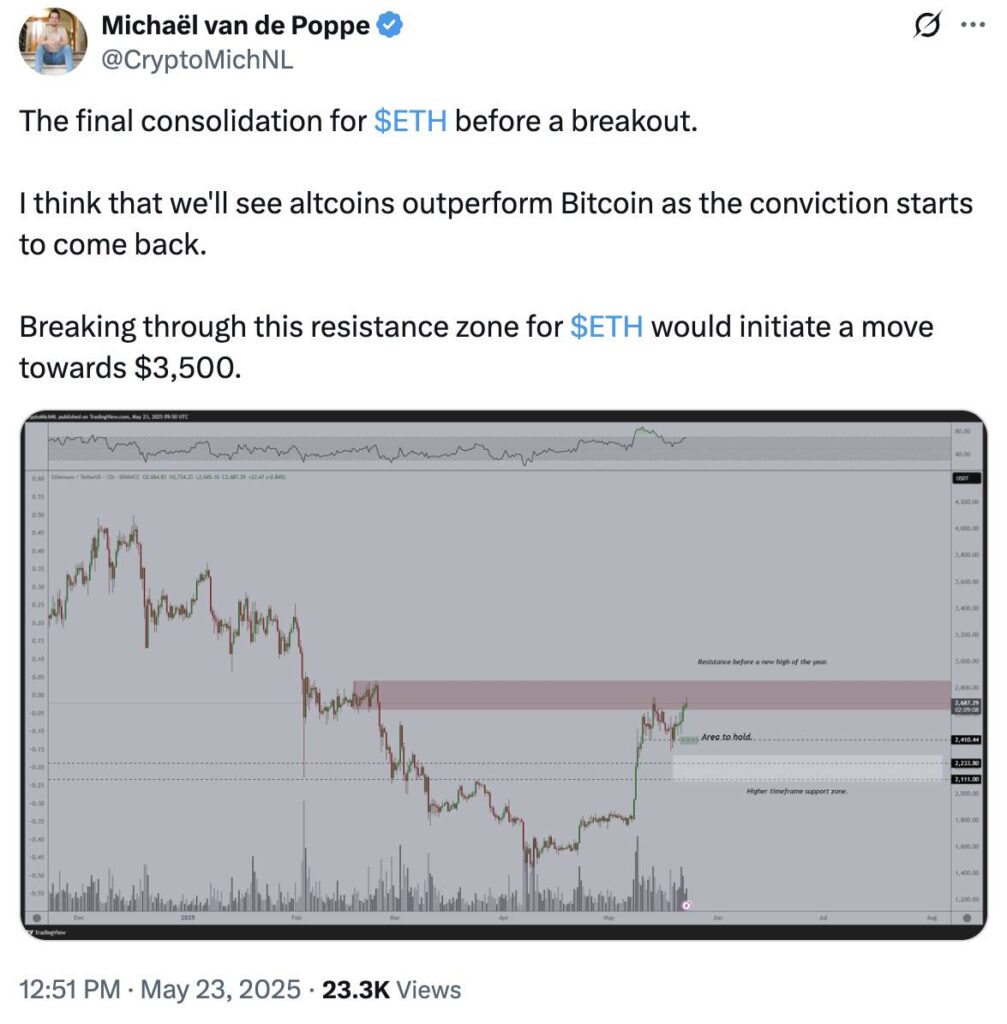Ethereum has recently captured the attention of the cryptocurrency space with a promising technical formation known as a “bull flag” on its daily chart. This setup has sparked speculation about a potential surge in Ether’s price, possibly reaching the significant milestone of $4,000. The excitement is fueled by a notable increase in network activity and the total value locked (TVL) within Ethereum’s smart contracts.
As of May 23, the price of Ether climbed to an impressive eight-week high of $2,734, marking a dramatic rise of nearly 56% from its earlier low of $1,750 on May 6. This upswing mirrors the market’s recovery, largely driven by Bitcoin’s record high prices and improving macroeconomic conditions. Ethereum’s daily transaction count witnessed a remarkable 37% increase in the last month, indicating a resurgence of user engagement on the network. Such activity levels haven’t been observed since early 2024—when market anticipation around U.S.-based Bitcoin ETFs propelled ETH prices above $4,000.
In tandem with rising transaction counts, Ethereum’s average transaction fees surged to a 90-day high, reaching approximately $1.33 on May 22. Elevated fees often signify robust network utilization, suggesting heightened market confidence among users engaging in DeFi projects, NFTs, and various decentralized applications (DApps). Historically, spikes in Ethereum’s transaction fees have correlated with periods of rising prices, as demand for the cryptocurrency typically escalates.
Moreover, the total value locked on Ethereum’s platform has also seen substantial growth, climbing from $45.26 billion in April to $65.3 billion by May 23—an increase of over 44%. This growth underscores Ethereum’s dominance in the layer-1 market, with a commanding market share of 54%, far outpacing competitors like Solana and BNB Chain.
“High utilization periods with high fees indicate growth in network activity or bullish sentiment, as more ETH is needed for gas, which can result in upward price pressure,” noted analysts analyzing the trends.
The surge in deposits within specific protocols, such as a 51% rise in Pendle and a 48% increase in both Ether.fi and EigenLayer, further supports the bullish outlook for Ethereum. Additionally, the influx of $249 million into U.S.-listed spot Ether ETFs between mid-May further amplifies demand within the ecosystem.
As the crypto community keeps a watchful eye on Ethereum’s movements, the potential for continued growth looms large. The formation of the bull flag and subsequent market actions sets the stage for what could be an exhilarating period for Ether as it strives to ascend towards $4,000 if current trends hold.
Key Takeaways on Ethereum’s Market Potential
Understanding the current trends in Ethereum can significantly impact your investment decisions and awareness of cryptocurrency dynamics.
- Bull Flag Formation:
- Ethereum is forming a bull flag pattern, indicating strong upward momentum.
- A breakout could potentially lead to a price target of $4,000.
- Network Activity Increase:
- Ethereum’s daily transaction count has risen by 37% over the past month.
- Rising transaction fees reached a 90-day high, suggesting increased user engagement.
- Total Value Locked (TVL) Growth:
- Ethereum’s TVL increased by over 44% in 30 days, reaching $65.3 billion.
- Ethereum still leads in market dominance with 54% of total TVL compared to its competitors.
- Positive Market Influences:
- U.S.-listed spot Ether ETFs saw $249 million in net inflows, enhancing demand.
- Market recovery, led by Bitcoin’s performance, positively affected ETH prices.
- Investment Considerations:
- Understanding these trends can help investors anticipate potential price movements.
- Staying informed about network activity and industry developments enhances risk management in investment strategies.
Ethereum’s Bullish Momentum: Standing Out in the Crypto Landscape
With Ethereum (ETH) establishing a notable bull flag on its daily chart, the prospect of breaking through the $4,000 threshold has attracted significant attention. This current market setup not only reflects Ethereum’s resilience but also offers a competitive edge against its primary rivals, such as Solana and Binance Smart Chain. As Ethereum’s transaction fees rise and its total value locked (TVL) soars by over 44% in just a month, it seems poised for potential gains that could pose challenges for competitors still grappling with lower market dominance and user engagement.
Advantages of Ethereum’s Positioning: One of Ethereum’s standout features is its strong network activity, indicated by a 37% increase in daily transactions. This spike suggests a flourishing ecosystem, particularly in sectors such as decentralized finance (DeFi) and non-fungible tokens (NFTs), where user interaction is crucial. In contrast, platforms like Solana and BNB Chain struggle to maintain comparable transaction volumes, highlighting Ethereum’s leadership role in the crypto space. Moreover, the influx of $249 million in net inflows into US-listed spot Ether ETFs signals robust institutional interest, reinforcing Ethereum’s status as a vital player in the market.
Disadvantages and Potential Challenges: Despite its current momentum, Ethereum faces challenges regarding scalability and transaction costs. As fees reach a 90-day high, concerns may arise over the sustainability of user engagement. High transaction fees could deter smaller investors, potentially leading to reduced network interaction during peak times. While Ethereum’s TVL remains unrivaled at 54%, it must continuously evolve to address these issues or risk losing ground to competitors offering lower fees and faster transaction speeds.
This bullish scenario could greatly benefit current Ethereum holders, particularly those invested in DeFi platforms that may harness the network’s growth to optimize returns. Conversely, potential setbacks, like the reluctance of new users to engage due to high transaction fees, could hinder Ethereum’s broader adoption, creating more adoption issues compared to platforms with lower entry barriers.
In summary, while Ethereum’s current positioning in the market presents significant opportunities, it remains crucial for stakeholders to be aware of surrounding dynamics, especially as rivals work to close the gap and attract their share of the ever-evolving crypto ecosystem.

















